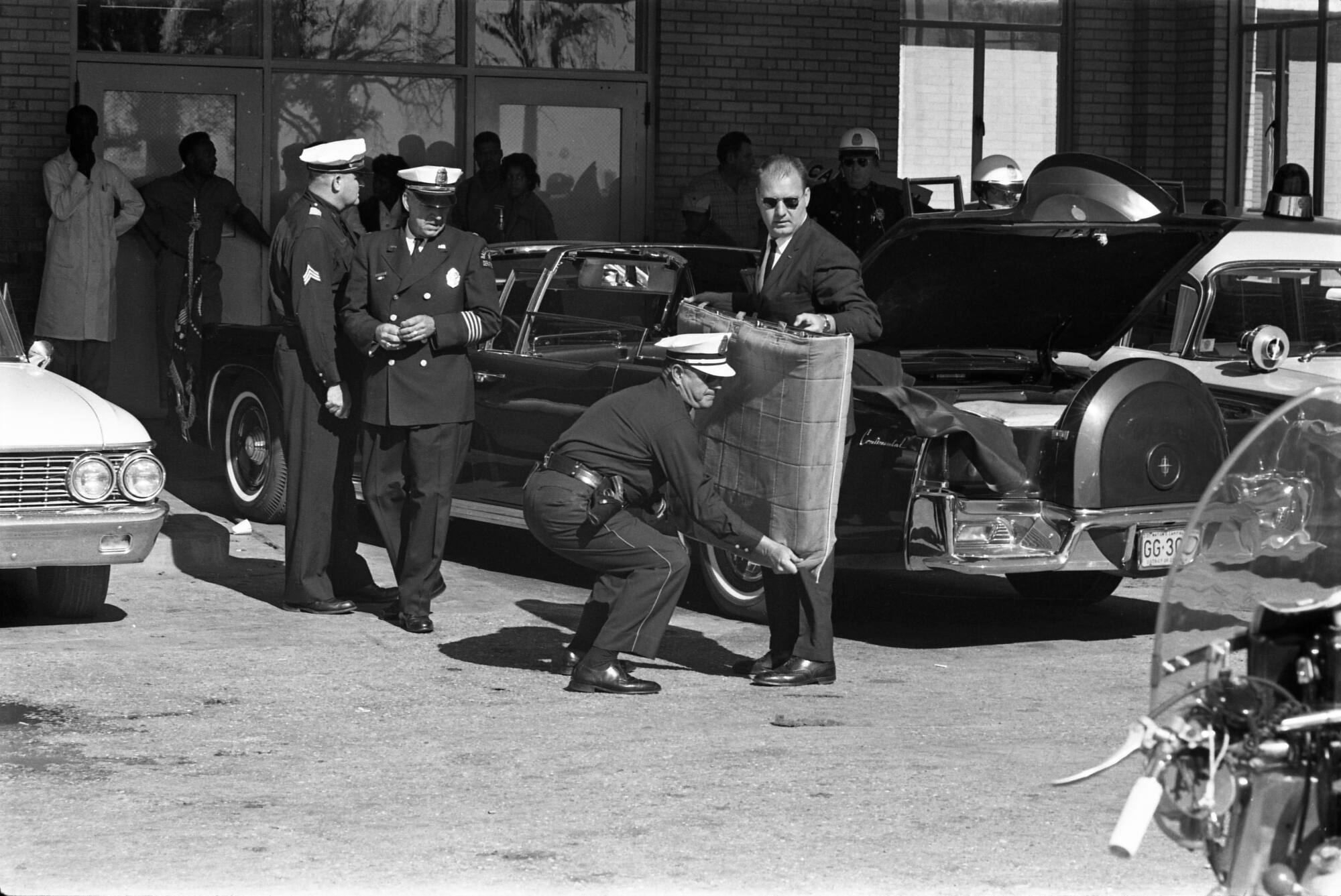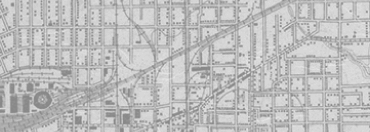


Back
Image of police officers at Parkland dealing with evidence from the limousine
Original black and white 35mm negative by a Dallas Morning News photographer. The image shows police officers outside Parkland Memorial Hospital assisting Secret Service agents with putting the top on the presidential limousine. Dallas police officer James Chaney is visible in the background.
Image of police officers at Parkland dealing with evidence from the limousine
11/22/1963
Film
1 x 1 1/2 in. (2.5 x 3.8 cm)
Tom C. Dillard Collection, The Dallas Morning News/The Sixth Floor Museum at Dealey Plaza
1994.003.0011.0006
No films or photographs are known to exist that show any of the occupants exiting or being removed from the presidential limousine at the emergency entrance to Parkland Memorial Hospital, just as there are no photographs showing President Kennedy inside Parkland Hospital following the assassination. Likewise, while several eyewitnesses got close enough to later describe the graphic condition of the limousine interior, no Dallas photographs are known to exist which clearly show inside the vehicle. The widely circulated color photographs showing the blood-stained limousine interior were actually taken inside the White House Garage by the FBI on Saturday, November 23, 1963. Black and white photographs (including Image AR406-6 in the Fort Worth Star-Telegram Collection at the University of Texas at Arlington Library) which show the inside of a vehicle at Parkland, with scattered roses visible on the floor of the backseat, are frequently misidentified as showing the interior of the Kennedy limousine. They are, in fact, all photographs showing the inside of Vice President Johnson's vehicle, which was a gray 1964 Lincoln four-door convertible (as opposed to the presidential vehicle, which was a modified blue Lincoln Continental convertible with jump seats). The yellow roses belonged to Lady Bird Johnson, as Mrs. Kennedy's roses, given to her at Love Field by the wife of Dallas Mayor Earle Cabell, were famously red. -- Stephen Fagin, Curator
The Kennedy limousine was the first presidential vehicle equipped with an optional transparent roof as well as a fabric roof covering that could be installed when the vehicle was not in use as a convertible. The six-piece roof system was composed of clear plastic panels that were stowed in the trunk when not in use, and they could be installed in various combinations for the rear, middle and front compartments of the vehicle. Despite numerous claims to the contrary, the cover or "bubbletop" was not bullet proof. -- Stephen Fagin, Curator

Image of police officers at Parkland dealing with evidence from the limousine
Original black and white 35mm negative by a Dallas Morning News photographer. The image shows police officers outside Parkland Memorial Hospital assisting Secret Service agents with putting the top on the presidential limousine. Dallas police officer James Chaney is visible in the background.
Image of police officers at Parkland dealing with evidence from the limousine
11/22/1963
Limousine
Photographs
Chaney, James
Dillard, Tom C.
The Dallas Morning News
Parkland Hospital
Secret Service
Dallas Police Department
Dallas
Film
1 x 1 1/2 in. (2.5 x 3.8 cm)
Tom C. Dillard Collection, The Dallas Morning News/The Sixth Floor Museum at Dealey Plaza
1994.003.0011.0006
No films or photographs are known to exist that show any of the occupants exiting or being removed from the presidential limousine at the emergency entrance to Parkland Memorial Hospital, just as there are no photographs showing President Kennedy inside Parkland Hospital following the assassination. Likewise, while several eyewitnesses got close enough to later describe the graphic condition of the limousine interior, no Dallas photographs are known to exist which clearly show inside the vehicle. The widely circulated color photographs showing the blood-stained limousine interior were actually taken inside the White House Garage by the FBI on Saturday, November 23, 1963. Black and white photographs (including Image AR406-6 in the Fort Worth Star-Telegram Collection at the University of Texas at Arlington Library) which show the inside of a vehicle at Parkland, with scattered roses visible on the floor of the backseat, are frequently misidentified as showing the interior of the Kennedy limousine. They are, in fact, all photographs showing the inside of Vice President Johnson's vehicle, which was a gray 1964 Lincoln four-door convertible (as opposed to the presidential vehicle, which was a modified blue Lincoln Continental convertible with jump seats). The yellow roses belonged to Lady Bird Johnson, as Mrs. Kennedy's roses, given to her at Love Field by the wife of Dallas Mayor Earle Cabell, were famously red. -- Stephen Fagin, Curator
The Kennedy limousine was the first presidential vehicle equipped with an optional transparent roof as well as a fabric roof covering that could be installed when the vehicle was not in use as a convertible. The six-piece roof system was composed of clear plastic panels that were stowed in the trunk when not in use, and they could be installed in various combinations for the rear, middle and front compartments of the vehicle. Despite numerous claims to the contrary, the cover or "bubbletop" was not bullet proof. -- Stephen Fagin, Curator









